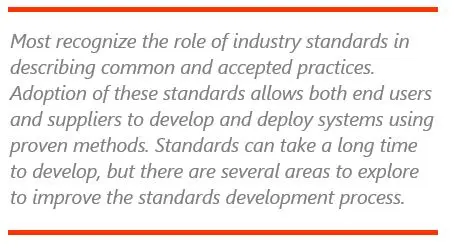

There are many views on the value and utility of industry standards, many of which include concerns and criticism about the processes used for their development. Perhaps the most common criticism is that standards take too long to develop, leading to  delays in making them available who could most benefit from their application. While the development time is due in part to the need for establishing a broad consensus on what constitutes common and accepted practice, there are no doubt opportunities for optimizing the process using improved tools and practices.
delays in making them available who could most benefit from their application. While the development time is due in part to the need for establishing a broad consensus on what constitutes common and accepted practice, there are no doubt opportunities for optimizing the process using improved tools and practices.
The development of standards requires careful consideration, broad consensus, and rigorous testing. While processes can be improved, it is essential to maintain the quality, credibility, and relevance of the standards being developed. There must be a balance between speed and thoroughness to ensure that the resulting standards meet the needs of industries and society. Accelerating the development of standards can benefit all stakeholders, including end users and product suppliers.
The analysis conducted in preparing this report resulted in several key findings:
Value – Standards are generally valued, but there are frustrations associated with their use. The time and effort required for their development can delay adoption and application. Also, the scope of applicability is often not clear, especially when multiple standards address the same subjects.
Variety – Standards come in many forms and are available from multiple sources. This makes it a challenge to select those most applicable to a given situation. Tutorials and other educational materials could help alleviate this confusion.
Process – Many standards development organizations (SDOs) still use manual and labor-intensive processes to develop their products. Many potential improvements in process and technology could improve this situation.
Feedback – Stakeholders must speak up and if possible, get more involved in standards development. This not only makes more experienced resources available but also allows the introduction of more modern tools and processes.
Most engineers and technical professionals would agree that industry standards are essential to the practice of their discipline. Reflecting common and accepted industry practice, standards are a valuable reference that removes the need to conduct all designs from a first principles analysis.
There are many ways in which standards provide value to those who apply them. This includes both product suppliers and end users. Standards can increase the level of consistency and interoperability between solutions from multiple sources. Closely associated with this are the quality of resulting solutions. Achieving this quality also increases trust on the part of the consumer. Standards can also promote innovation by reducing the likelihood of “reinventing the wheel.” If standards already exist, the innovator can build upon them to develop new solutions. Even without innovations, standards can provide a solid basis for continuous improvement efforts.
There are certainly challenges associated with the development and use of standards. Lack of understanding and clarity about the types of guidance available can reduce or slow standards adoption. Standards come in several forms, including discipline-defined, industry or sector-specific, and regulation-driven. Further complicating things is the fact that other types of information such as frameworks and guidelines may also be seen as “standards,” when in fact, this is not their intent. The similarities and differences between types of available guidance have been addressed in previous ARC research.
The time and effort required to develop and deliver standards can also be problematic. While both suppliers and end users commonly wish to have standards available to guide their decisions, most would like to have them available sooner. It is a common situation that the need for informal guidance appears well before standards have been completed. Some of this is an inevitable consequence of the fact that standards must reflect “common and accepted practice” and thus lag the emergence and general availability of new technology and associated practices. However, there are clear benefits associated with improved standards development processes.
As challenging as development may be, it is common to have a choice of several standards with similar or overlapping scopes. Some may have been developed within an industry sector, while others may have been created to address pending or existing regulations. Regardless of the details, the result is that the end user or product supplier may have to choose between several potentially applicable standards.
Executive Overview
The View of Industry Standards
Standards Development Processes
Opportunities for Improvement
Conclusion
Recommendations
ARC Advisory Group clients can view the complete report at the ARC Client Portal.
Please Contact Us if you would like to speak with the author.
Learn new ideas, establish valuable relationships, and refine your company's strategy at ARC’s Upcoming Forums.

